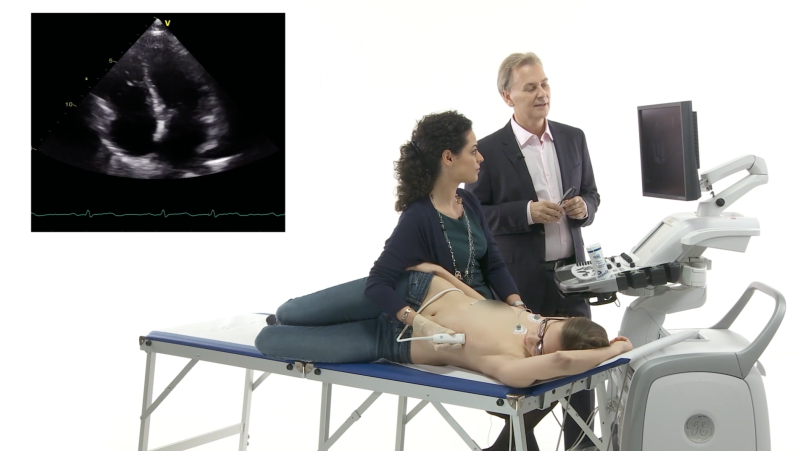Elementary Watson
From observation to conclusions
“It is simplicity itself, Watson ... My eyes tell me that on the inside of your left shoe… the leather is scored by six almost parallel cuts. Obviously they have been caused by someone who has very carelessly scraped round the edges of the sole in order to remove crusted mud from it. Hence, you see, my double deduction that you had been out in vile weather, and that you had a particularly malignant boot-slitting specimen of the London slavey”. Yes, it’s true, this Sherlock Holmes was quite a smart guy! In "A Scandal in Bohemia" he deduces that Watson has got very wet lately and has a careless servant girl just by looking at his shoe! Now, with the same most simple way of thinking, I suggest you to approach the following clinical case.
Mrs. Mary from downtown
It was almost noon when Mrs. Mary, a 62 year old woman from southern Austria, entered the echo lab. In the last few months she had been complaining about exertional dyspnea. Her medical history was quite poor: she had never been admitted to hospital all her life long and, actually, she did not like doctors at all! Her ECG showed nothing special and her labor findings were within normal ranges, apart from her Brain Natriuretic Peptide (BNP) level, which was 700 pg/ml.
Our observations
We performed a transthoracic echocardiogram on Mrs. Mary and immediately discovered what her problem was. I am sure the following two images will bring you up to the same conclusion of ours.
Apical four-chamber view, the mitral valve looks quite normal.
Apical four-chamber view with color Doppler.
Right to the deduction
It’s not hard to say that the cause for Mrs. Mary’s symptoms was severe mitral regurgitation (MR). However, it’ s not as easy to understand which mechanism was responsible for it. Look carefully at her mitral apparatus. Left ventricular (LV) function was preserved and the LV size was within normal ranges. There were no abnormalities involving both papillary muscles and chordae tendineae. The mitral annulus was not dilated and both mitral leaflets looked thickened but normal. Even their coaptation seemed preserved!
What’s behind the curtains?
Sherlock Holmes would now say : ”Elementary, my dear Watson!”. And, as a matter of fact, the solution got quite clear after we looked at the continuous wave (CW) Doppler signal of the mitral regurgitant jet.

CW Doppler mitral regurgitant jet. The velocity is 6.8m/s.
This suggests systolic hypertension!
I know it’s not common to take this parameter into account during a standard examination, but it helped us a lot in this case. We are used to always looking at the gradient across the tricuspid valve to assess systolic right ventricular (RV) pressure. In the absence of RV outflow tract obstruction or pulmonary valve stenosis, this pressure equals systolic pulmonary artery pressure (sPAP). Acting like real detectives, we used the same principle to assess systolic LV pressure, which corresponds to systolic aortic pressure in the absence of LV outflow tract obstruction and aortic valve stenosis. In our case, peak mitral regurgitant jet velocity was around 6,8 m/sec which corresponded to a transmitral pressure gradient (ΔP) of 185 mmHg! And, what’s more, in order to derive systolic LV pressure (sLVP), we still had to add an estimated systolic left atrial pressure (sLAP) to this value (transmitral ΔP = sLVP – sLAP; sLVP = transmitral ΔP + sLAP). Suspecting that our patient’s systolic blood pressure was around 200 mmHg, we measured it from both her arms. No tricks, my dear, everything was in broad daylight! Look at the result yourself.

Systolic blood pressure of 202 mmHg.
Defeating the disease
In order to prove the direct connection between high blood pressure, increased LV after load and functional MR in the absence of any relevant valvular disease, we gave Mrs. Mary 1 dose nitroglycerin spray and…MR got mild!
Apical four-chamber view with color Doppler.
Here is a comparison: Before and after Nitroglycerin.
And YES this is the same patient!
And what happened to her blood pressure?
Nitroglycerin certainly worked!

Systolic blood pressure 129 mmHg.
An open-and-shut case
I must confess…it had never been so easy to treat a “valve disease”! As a matter of fact, we suggested Mrs. Mary to hold her blood pressure in check and eventually start an appropriate antihypertensive treatment. From that day on, after getting such an easy solution to her problem, Mrs. Mary was not scared of doctors anymore!
Any take-home messages from this case? Sure! Valve diseases are extremely dynamic and dependent on loading conditions. Decision making on their treatment could be hard. Sometimes, however, the solution is behind the corner and it only takes a good detective to discover it!

Anna- Maria Pistritto.
Best,
Anna- Maria
PS: If you want to read more on mitral regurgitation and echo, here are a few case stories and demos you might like:
Catching the right moment
Jet direction and mechanism in mitral regurgitation
Where is waldo – part 2
Perforated mitral valve
Second look
PPS: Don´t forget to post your comments below!


